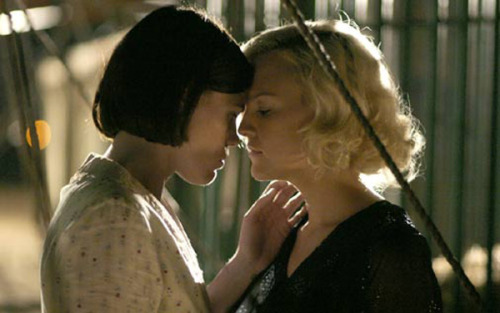The apocalypse at the center of Carnivale — a heavily hyped battle between agents of good and evil that devolves into silly histrionics at series cancellation — layers a foundation of doom for small, strategically-placed epiphanies. The deeply wrought American-style poverty, dirt, dust storms, yellow and soot camera filters, chaw spittle, bad teeth, five-day growth, soiled clothes, matted hair, malnutrition percolated, matched well by plot. Carny management regularly cheated customers and relied on backlot prostitution, with one character pimping out his wife and daughters. The stink and the desperate showbiz chicanery emanated equally. Inhabiting the same time period as the rise of the American gangster, the series illustrated a similar trend towards crookedness. The all-white carny troupe exhibited racist opinions as well as experienced bigotry in the townie distaste for them. The title sequence alluded to Sodom and Gomorrah, an empire on the verge of collapse, the Dust Bowl and the Great Depression the sign of End Times. The production design by Dan Bishop (production designer), Roger L. King (art director), David Morong (art director) and Joyce Anne Gilstrap (set decorator) was magnificent.
But the darkness was intended simply as a carrier for brief moments of bliss: romantic encounters, a healer bringing people back to life. Carefully modulated scenes drew out surprises. Essentially immoral characters faced situations that motivated compassion and even spiritual awareness.
The score by Jeff Beal, now better known for House of Cards, along with theme music by Wendy & Lisa and a big crew of sound and music editors and composers, underline the End Times and the small miracles hidden within; cacophony is cut with a harmonica, dissonance with a smooth violin line, stuttering horns, scuttling room noises, squeals, whooshes, people talking in tongues, fateful, low oboe-like sounds, descending piano notes, are redirected by eccentric tempo changes and embellished with a reoccurring tune played on mandolin, or by an angelic choir. A formalistic sound template evolves: sound effects, perhaps of hellish origins, enhance the dread of the storyline in progress, but when good things happen identifiable melodies emerge. At these moments the score mostly avoids the cliches of swelling violins, cutting them with something more Romani-like. It’s a soundtrack for the Apocalypse, but the hopeful kind.
More can be heard here:
Jeff Beal CARNIVALE
